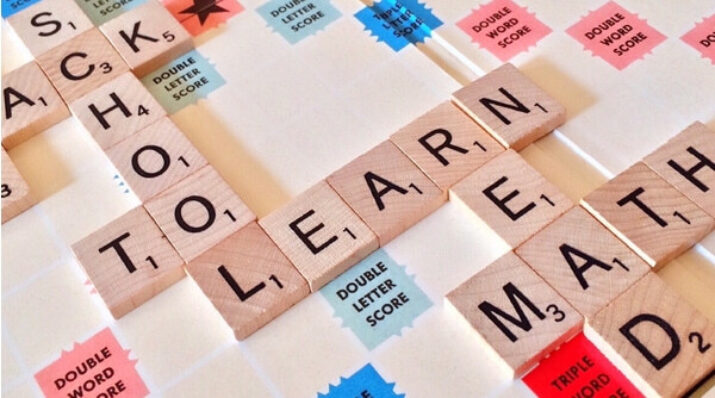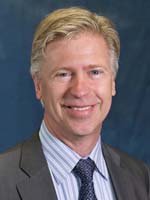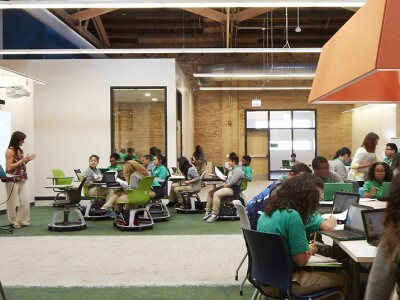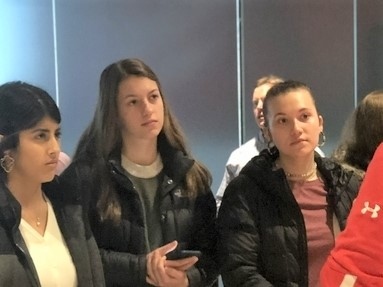Students and Teachers Owning Personalized Learning at Bill Reed Middle School
Topics

We’ve all had the experience of truly purposeful, authentic learning and know how valuable it is. Educators are taking the best of what we know about learning, student support, effective instruction, and interpersonal skill-building to completely reimagine schools so that students experience that kind of purposeful learning all day, every day.
Leaders across Thompson School District visited Bill Reed Middle School to see how the school is adapting under the district's push to personalize learning.
The three-story brick exterior of Bill Reed Middle School looks much as it did when the building first opened as Loveland High School in 1918.
Serene. Staid. Calm.
Inside, it’s a whole different story.
Sixth-grade math class is a blur of student motion. The classroom buzzes with activity. Students huddle in groups around questions posted on the walls on the second floor classroom, then seek approval and stars from their teacher before dashing upstairs to another room to look for a fresh round of problems. An airplane travels 2,552 miles in 5.5 hours. What is the speed of the airplane in miles per hour?
Students are on their feet in the science classroom, too. They are studying genetics, using goldfish crackers and Punnett squares to determine the probability of an offspring having a particular genotype.
Down in the social studies room, students are working in groups developing smartphone apps. Student Mel Castillo’s idea is to give shoppers an easy way to buy customized shoes. “You can customize the color and what style you want it to be,” says Castillo, “if you can make your own shoe, you can make it something you really like.”
The students in Jack Davies’ class pitched their ideas for apps to the entire class, as a practical way of learning the basics of the ‘demand’ side of supply and demand. And teams worked on sharpening their ideas to differentiate themselves from the competition.
On January 11, 2018, Bill Reed Middle School hosted the seventh stop of Thompson School District’s ‘Seeing is Believing’ tour, which affords district staff and district partners an opportunity to see how schools are adapting under Thompson School District’s push to personalize learning.
As principal, I know that our school is on the road to implementing the personalized approach but is not quite there—yet.
Our teachers are getting better at being more flexible in their approach to the use of the physical space. Given the age of the building, some of the classrooms are on the small side. Some of our teachers are developing a ‘comfort of letting go’ of traditional approaches to classroom teaching and learning.
Our school is working with teachers on their ability to adjust teaching based on individual student needs. The old approach was to give an assessment to a class of students, record scores in the grade book, and move on to the next unit. Detailed assessment tools like i-Ready, however, mean teachers know precisely what skills each student needs to develop. The results allow teachers to customize instruction to meet individual student needs. I estimate that about a third of the Bill Reed staff has embraced personalized learning.
Teacher turnover hasn’t helped; 50 percent of the language arts team is new this year, and so is 50 percent of the seventh grade team.
The school recently took all sixth-graders on a major problem-based learning project that involved the Big Thompson Master Plan. The work started with a simple question: how does living near the Big Thompson River impact the lives of the citizens of Loveland?
The city is planning to revitalize the nine miles of the river corridor and students investigated the geography, flood resilience, accessibility, habitat, and overall health of the river. They met with some of the city planners, too, and developed questions for a panel of Loveland citizens. The work emphasized critical thinking from start to finish. An arts component meant students used transparencies over photographs to show their analysis as well as ideas for improvement.
“Anytime we’ve had to practice geographic thinking, since then, or using the theme of human-environment interaction, all I have to say is ‘guys, think of what we did with the Big Thompson Master Plan’ and right away the kids are like, ‘that’s what it’s like to think like a geographer, that’s what human-environment interaction is all about.’ It was a powerful anchor point for our future use and application of that skill,” says social studies teacher Luke Appleton.
At Bill Reed Middle School, ‘Power Hour’ is targeted at helping students improve their focus and study habitats. The school has noted that boys in particular are ‘overdisciplined and underachieving,’ notes assistant principal Chris Frank. So now Power Hour includes options like Pictionary, charades, and yoga. “We used to dim the lights but now we just get down and do it,” says Power Hour coach Andrea Walker. Everyone can do warrior, tree, and many other basic yoga poses with ease, she reports. The fun improves team building and general camaraderie.
“When you get all sides of brain firing while you’re studying, you actually remember better,” says Walker. “Nontraditional athletes figure out juggling like that,” she says, snapping her fingers.
Bill Reed Middle School recently was upgraded to ‘performance’ under the state’s accreditation plan. And while new teachers are being introduced to our approach to personalized learning, I believe that progress is evident.
Our students are much more interested in owning their own work. They’re not only owning the learning; they are owning the understanding of what competency looks like. So now what is really shifting is students saying ‘what can I do to get a 4?’ We’re seeing the dialogues change between teachers and students. We’re seeing those kinds of trends in all three grades. And that’s a real positive.
Take the Seeing Is Believing Tour
- We See and Believe in Thompson School District
- Teaching & Learning Is an Open Book at Turner Middle School
- Student Success in a Fast-Evolving World at Loveland High School
- Learning Spaces Redefine Learning at High Plains School
- Learning by Doing at Ferguson High School
- Developing Critical, Creative, and Reflective Thinkers at Lucile Erwin Middle School
- Students and Teachers Owning Personalized Learning at Bill Reed Middle School
- Personalizing Learning with Music and Art at Mountain View High School
- Multidisciplinary Projects at Walt Clark Middle School
Photo by Today Testing via Wikimedia. CC BY-SA 4.0




